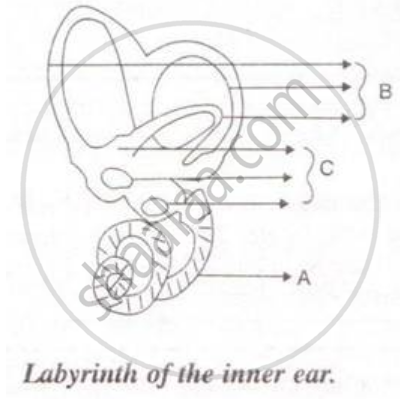Advertisements
Advertisements
Question
Which part of our ear is shaped like a snail shell?
Options
Semi-circular canals
Cochlea
Stapes
Eustachian tube
Solution
Cochlea
APPEARS IN
RELATED QUESTIONS
Write short notes on the following Ear ossicles
The number of oscillations per second of a vibrating object is called its time period.
(i) Draw a well labelled diagram of the membranous labyrinth found in the inner ear.
(ii) Based on the diagram drawn above in (i) give a suitable term for each of the following descriptions :
1. The sensory cells that helps in hearing.
2. The part that is responsible for static balance of the body.
3. The membrane covered opening that connects the middle ear to the inner ear.
4. The fluid present in the middle chamber of cochlea.
5. The structure that maintains dynamic equilibrium of the body.
The three parts of human ear contributing in hearing are-
Differentiate between members of the following pair with reference to what is asked in bracket.
Semi-circular canal and cochlea (Senses perceived)
Mention if the following statement is true (T) or false (F) Give reason.
Malleus incus and stapes are collectively called the ear ossicles.
How could you convince a small child that when you speak, it is not necessary for air to travel from you mouth to the ear of listener?
Name the three tiny bones present in the middle part of ear.
Write whether the following is true or false:
The part of the ear associated with balance is the cochlea.
Given below is a diagram of a part of the human ear. Study the same and answer the question that follow:

Name the parts labeled A, B and C in the diagram.
The following diagram refers to the ear of a mammal.

(i) Label the parts 1 to 10 to which the guidelines point.
(ii) Which structure:
(a) converts sound waves into mechanical vibrations?
(b) Converts vibrations into nerve impulses?
(c) Responds to change in position?
(d) Transmits impulses to the brain?
(e) Equalizes atmospheric pressure and pressure in the ear.
Mention, if the following statement is True or False
Deafness is caused due to the rupturing of the pinna.
State the functions of the following:
Semi-circular canals
Describe the structure and function of the human ear?
The Eardrum moves inward when a rarefaction reaches it.
Choose the odd one out from the following terms and name the category to which the others belong:
The part of the inner ear which is responsible for hearing is ______.
Which of the following structures equalises the air pressure on either side of the tympanum?
Note the relationship between the first two words and suggest the suitable word/words for the fourth place.
Ears: Auditory nerve :: Eyes : ______.
- Draw a neat and well labelled diagram of the membranous labyrinth found in the inner ear.
- Based on the diagram drawn above in (i), give a suitable term for each of the following descriptions:
- The structure responsible for hearing.
- The sensory cells that help in hearing.
- The membrane-covered opening that connects the middle ear to inner ear.
- The nerves that carry impulses from the ear to the brain.
- The tube which equalises the air pressure on either side of the ear drum.
